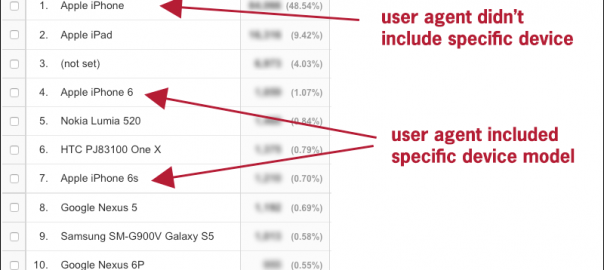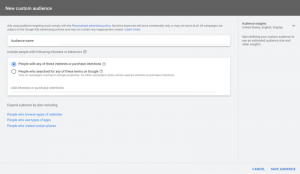When iOS user agents include a specific device model, Google Analytics now lists them separately in the Mobile > Devices report.

If you’re a Google Analytics user and you’d like to know which iOS models and devices your visitors are using, there’s good news and bad news.
The good news: When it can, Google Analytics is now breaking out specific iPhone and iPad models and listing them separately in the Audience > Mobile > Devices report.
The bad? The “when it can” part of that equates to “very rarely” right now.
Let’s dive deeper into what’s going on….
Before: all iOS traffic lumped together
For years, that Mobile > Devices report lumped all iOS traffic together under either the “Apple iPhone” or “Apple iPad” labels. That’s because, traditionally, iOS user agents didn’t indicate a specific device model. And, for the most part, that’s still the case. But not always, as I’ll explain below.
Meanwhile, many other devices are reported separately by model. In the Mobile > Devices report, you should be able to see separate traffic data for the Google Nexus 5 vs. Google Nexus 5X, for example, or the Samsung SM-G900V Galaxy S5 vs. the Samsung SM-G900F Galaxy S5, and so forth.
Now: some iOS devices are broken out
Earlier this week, I noticed for the first time that the Mobile > Devices report was listing specific iPhone and iPad models in addition to the normal and unspecific “Apple iPhone” and “Apple iPad” list items. I’m seeing this across every web site that I have access to in Google Analytics, and you should see some iOS traffic broken out, too.
A Google spokesperson tells us that the company recently began to notice a small amount of iOS that included a different user agent — one that specifically indicated the device and model. So, when it sees this user agent, Google Analytics is now distinguishing iOS traffic by device and model.

But Google tells us — and the blurred screenshot above confirms — that the device and model is available for only a very small amount of iOS traffic, and only when tracked from in-app browsers.
Above, you can see that the generic “Apple iPhone” still makes up more than 48 percent of all mobile traffic, and the iPhone 6 and 6s combine for less than two percent. It’s safe to assume that a lot of the “Apple iPhone” traffic is from the 6 and 6s, but the user agents for that traffic didn’t indicate that.
How to count your iOS traffic now
All of this begs a question: What’s the difference between “Apple iPhone” and “Apple iPhone 6s,” and how should users count their iOS traffic?
Google tells us that the “Apple iPhone” line item counts traffic that Google knows is from an iPhone, but doesn’t know the exact model. And the line items for specific devices and models are separate; i.e., the number you’ll see for “Apple iPhone” does not include the traffic that’s broken out for “Apple iPhone 6s” and other models. So, to get your total iPhone traffic, you’ll need to add “Apple iPhone” and all of the rows that include a specific iPhone model.
We’ve reached out to Apple to ask why some of its iOS traffic is now including device and model in the user agent, and if Apple plans to include that data more often going forward. We’ll update this article if we get a reply.
Marketing Land – Internet Marketing News, Strategies & Tips
(23)
Report Post






